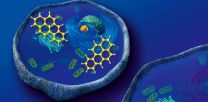Leipzig/Berlin. A public and scientific discussion is currently taking place focusing on the question whether substances at low concentrations may lead to health impairments in humans. For this reason, an increasing number of experimental studies to test such effects are currently conducted using different chemicals. It was possible to demonstrate, for example, that even low quantities of benzo[a]pyrene can have effects on the protein pattern and hence the metabolism and signal pathways in cells, even though the concentration is a hundred times below what is required to drive cells directly into apoptosis. This is the conclusion of studies undertaken by the Helmholtz Centre for Environmental Research (UFZ), Dresden University of Technology, and the German Federal Institute for Risk Assessment (BfR). These studies have now been published in the Journal of Proteome Research. The analysis of interlinked signal pathways taking advantage of different so-called "omics" technologies seems much more suitable for describing and monitoring unwanted effects than then previously used individual biomarkers.
The scientists undertook a detailed study of the effects of benzo[a]pyrene as a genotoxic model substance in cell cultures. Benzo[a]pyrene is long been known and one of the best studied carcinogenic substances. According to the current state of knowledge, there is no dose level without an effect, i.e. once reaching cells and tissues any quantity can be harmful. Ideally, consumers should never come into contact with such substances. The quantity of the substance in food must be reduced to levels as low as reasonably achievable. This approach is called the ALARA principle. Benzo[a]pyrene is a polycyclic aromatic hydrocarbon which is generated during incomplete combustion of organic materials. This means that it is very common and can be found, for example, in the smoke of cigarettes and in grilled meat.
Liver cells of mice were subjected for 24 hours to both a toxic and a benzo[a]pyrene concentration which was clearly below a threshold at which changes in the cell culture are typically observed. The changes in the levels of proteins and metabolites in the cells were then analysed. In this way, 190 proteins were identified - for a concentration that is toxic to the cell - which as a result of the treatment with benzo[a]pyrene underwent changes in their cellular quantity. At a concentration of only 50 nanomolar (nanomoles per litre) of benzo[a]pryrene, as many as 150 proteins were still found to be altered in their cellular levels. These effects of generally non-cell-toxic concentrations were clearly detectable in the case of benzo[a]pryrene and could not be predicted by effects of directly toxic concentrations.
By recording thousands of proteins and hundreds of metabolites, the chemically induced processes within cells can be described in detail. The large number of recorded molecules permits, on the basis of known functional connections, documenting the cellular reaction at the level of physiological signal pathways. Since a multitude of different proteins and metabolites are summarised for this purpose, the statement on a given signal pathway becomes clearly more robust and reliable than would be the case if a single protein was measured. The description of the effects of unwanted substances by means of this technique is also known as toxicoproteomics.
Benzo[a]pyrene is one of 105 substances which are classified as carcinogen by the International Agency for Research on Cancer (IARC). According to estimates, each US citizen, for example, on average absorbs 200 nanograms of benzo[a]pyrene per day. Due to the carcinogenic effect and prevalence of this substance, there is keen interest in understanding the underlying molecular mechanisms. In general, the presence of benzo[a]pyrene in the environment, which is also formed during natural incomplete combustion of organic substances, is to be considered unavoidable. The methods used in the research project confirms that concentrations of benzo[a]pyrene should ideally be minimised to such an extent as is "reasonably achievable" to prevent harmful health effects. Toxicoproteomic methods should in future also increasingly be used for analysing the effects of selected model substances for liver, immune cells, and other tissues.
INFORMATION:
Publications:
Stefan Kalkhof, Franziska Dautel, Salvatore Loguercio, Sven Baumann, Saskia Trump, Harald Jungnickel, Wolfgang Otto, Susanne Rudzok, Sarah Potratz, Andreas Luch, Irina Lehmann, Andreas Beyer, Martin von Bergen (2015): Establishing the pathway and time-resolved benzo[a]pyrene toxicity on Hepa1c1c7 cells at toxic and subtoxic exposure. J. Proteome Res. 14: 164-182.
http://dx.doi.org/10.1021/pr500957t
Murugaiyan, J., Rockstroh, M., Wagner, J., Baumann, S., Schorsch, K., Trump, S., Lehmann, I., von Bergen, M., Tomm, J.M. (2013) Benzo[a]pyrene affects Jurkat T cells in the activated state via the antioxidant response element dependent Nrf2 pathway leading to decreased IL-2 secretion and redirecting glutamine metabolism.
Toxicol. Appl. Pharmacol. 269: 307-316.
http://dx.doi.org/10.1016/j.taap.2013.03.032
Both studies were funded by the Helmholtz Alliance on Systems Biology and the Helmholtz Graduate School HIGRADE.
Further information:
Prof. Dr. Martin von Bergen
Department für Proteomics, Department für Metabolomics
Helmholtz Centre for Environmental Research (UFZ)
Tel.: +49-(0)341- 235-1211
http://www.ufz.de/index.php?en=17634
and
Dr. Stefan Kalkhof
Department für Proteomics
Helmholtz Centre for Environmental Research (UFZ)
Tel.: +49-(0)341- 235-1354
http://www.ufz.de/index.php?en=17567
or via
UFZ press office (Tilo Arnhold, Susanne Hufe)
Phone: +49-(0)341-235-1635, -1630
http://www.ufz.de/index.php?en=640
and
BfR press office
Tel.: +49-(0)30-18412-4300/-4301/-4302/-4303
http://www.bfr.bund.de/en/the_press_office___contacts-59833.html
Further Links:
Effect of Volatile Organic Compounds on the protein expression of Human immune cells: http://www.ufz.de/index.php?en=15010
Helmholtz Alliance on Systems Biology:
http://www.helmholtz.de/en/helmholtz_centres_networks/helmholtz_alliances/systems_biology/
http://www.helmholtz.de/pakt_fuer_forschung_und_innovation/impuls_und_vernetzungsfonds/helmholtz_allianzen/systembiologie/projekt_website_systembiologie/netzwerke_des_helmholtz_verbunds_systembiologie/from_contaminant_molecules_to_cellular_response_system_quantification_and_predictive_model_development/


